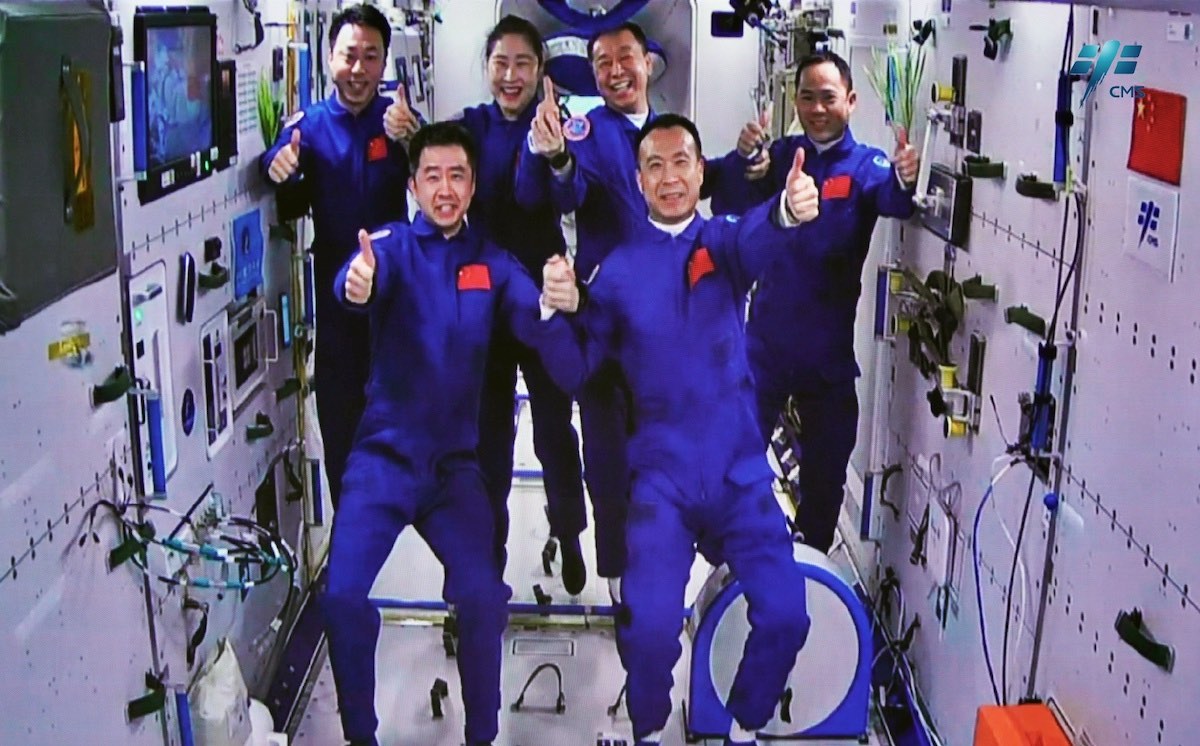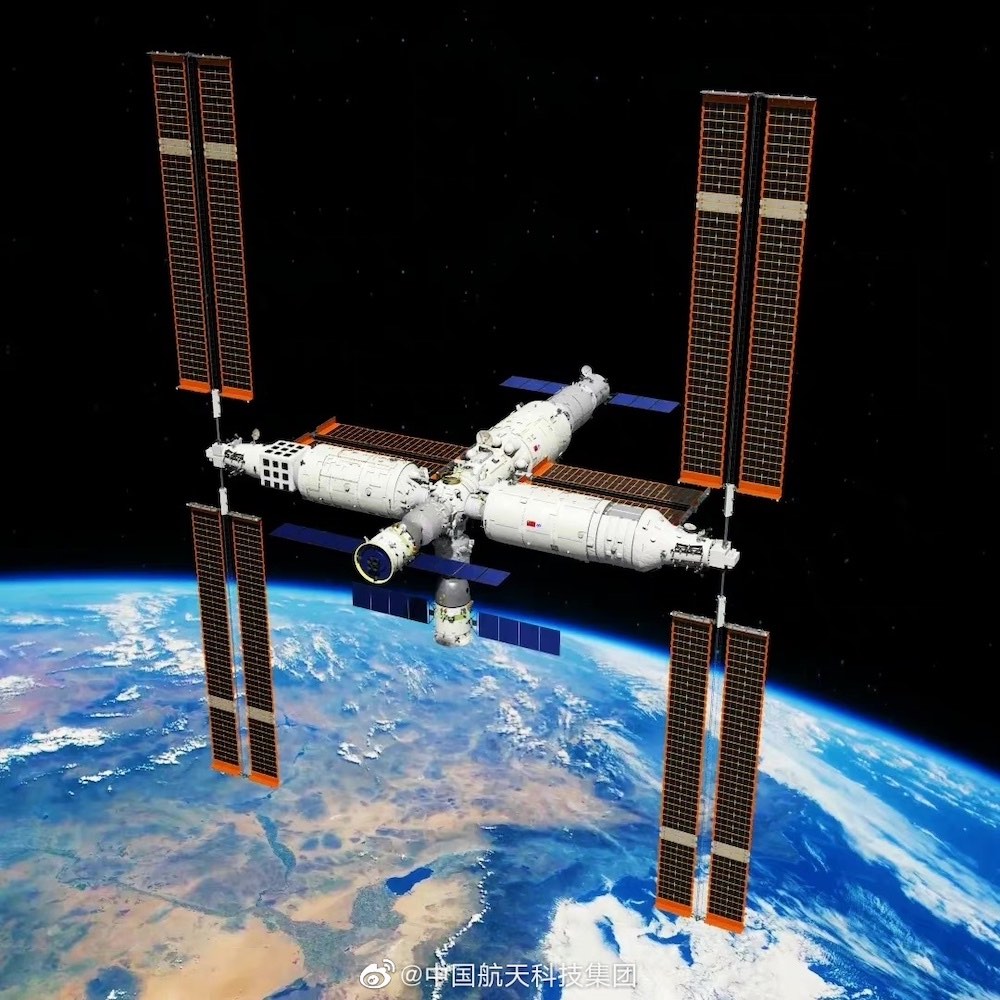
Three Chinese astronauts were greeted by three of their colleagues Tuesday as they floated into the Tiangong space station following a launch on a Long March rocket earlier in the day, marking the first time China’s space program has had six astronauts in orbit at the same time.
The new arrivals docked with the Tiangong space station in their Shenzhou 15 spacecraft at 4:42 p.m. EST (2142 GMT) Tuesday, about six-and-a-half hours after launch from the Jiuquan space center in the Gobi Desert of northwestern China. A Long March 2F rocket took off in sub-freezing temperatures at 10:08 a.m. EST (1508 GMT) and powered off the pad with 1.4 million pounds of thrust.
The liquid-fueled launcher jettisoned its four strap-on boosters and first stage, and the Long March’s second stage delivered the Shenzhou 15 spacecraft into orbit nearly 10 minutes into the mission.
A camera inside the Shenzhou 15 crew cabin showed commander Fei Junlong flanked by astronauts Deng Qingming and Zhang Lu as the rocket accelerated into low Earth orbit. The three-man spaceship extended its power-generating solar arrays moments after separating from the Long March 2F rocket, setting the stage for a series of thruster firings to match orbits with the Tiangong space station.
Shenzhou 15 autonomously docked with the forward port of the space station’s Tianhe core module as the vehicles soared at an altitude of some 240 miles (390 kilometers).
The arrival of Shenzhou 15 brought the total mass of the Tiangong space station to near 100 metric tons, its largest configuration yet with two Shenzhou crew vehicles and a Tianzhou cargo ship docked. The Tiangong station is the second-largest spacecraft in orbit, only exceeded by the 450-ton International Space Station led by NASA and Russia’s space agency.
Liftoff of China’s Long March 2F rocket with the Shenzhou 15 mission, carrying a crew of three astronauts into orbit in pursuit of China’s Tiangong space station. https://t.co/kKiruS4ZKb pic.twitter.com/R0bGJBz1T6
— Spaceflight Now (@SpaceflightNow) November 29, 2022
Fei, Deng, and Zhang opened hatches and floated into the Tianhe core module at 6:33 p.m. EST (2333 GMT) to join Chinese astronauts Chen Dong, Liu Yang, and Cai Xuzhe, who arrived at the Tiangong station June 5 on the Shenzhou 14 spacecraft. The Shenzhou 14 astronauts took the place of the Shenzhou 13 mission that ended in April. This time, the crew handover between the Shenzhou 14 and 15 astronauts is occurring aboard the Tiangong space station.
Live video from the space station showed the Shenzhou 14 and 15 astronauts greeting one another with hugs and handshakes, then posing for group photos. The six astronauts will live together on the station for five days before Shenzhou 14’s departure Sunday, setting the stage for re-entry and landing in a remote region of the Gobi Desert.
During their six-month mission, the Shenzhou 14 astronauts saw the arrival of the second and third major elements of the Tiangong space station. China launched the Wentian science lab July 24, then the Mengtian module Oct. 31. The modules initially docked with the forward port of the station’s Tianhe core module, then were moved to radial ports using a robotic arm to give the Tiangong outpost a distinctive “T” shape.
China launched the unpiloted Tianzhou 5 cargo ship to the space station Nov. 12. The Shenzhou 14 astronauts also completed three spacewalks to further outfit the space station.
“They witnessed many historical moments of China’s manned spaceflights,” said Ji Qiming, assistant to the director of the China Manned Space Agency, speaking about the Shenzhou 14 crew.

Chinese officials revealed the identities of the astronauts on the Shenzhou 15 mission Monday. In contrast to the U.S. and Russian space programs, China typically keeps its crew assignments secret until the day before launch.
Fei, 57, commanded the Shenzhou 6 mission in 2005, China’s second crewed flight to low Earth orbit. He spent nearly five days in orbit on Shenzhou 6 before returning to space again 17 years later.
“Today, I am very proud and excited to be able to go to space again for my country,” Fei said Monday in brief remarks to news media gathered at the Jiuquan launch site. “Especially when we are about to enter our own Chinese space station, I am deeply proud and proud of our great motherland.”
“The Shenzhou 15 mission is not only the last of the construction period of China’s space station, but also the beginning of the next new stage,” Fei said. “During the half-year flight, we will conduct more on-orbit tests, and the operation, maintenance and repair of equipment.”
Chinese officials said the Shenzhou 15 astronauts will head outside the Tiangong space station for three or four spacewalks to complete tasks that Fei described as “more arduous” and “more complicated” than previous Chinese spacewalks.
“Therefore, we have carried out a lot of targeted training on the ground,” said Fei, a major general in the Chinese Air Force. “Through the training, we also have enough confidence to complete this key link between the past and the future.”

Fei and his crewmate Deng Qingming, a 56-year-old former Chinese Air Force fighter pilot, were selected in China’s first class of astronauts in 1998. But Deng had to wait a quarter-century for his first flight to space.
“We deeply know that it is thousands of aerospace science and technology workers who support us to fly,” Deng said. “Here, I would like to pay tribute to all Chinese astronauts and thank you for your hard work. We will definitely complete this mission successfully.”
Zhang, 46, is another former fighter pilot in the Chinese Air Force. He joined China’s astronaut corps in 2010, and Shenzhou 15 is his first space mission.
“I am very much looking forward to experiencing the wonderful feeling brought by weightlessness, very much looking forward to building our own space home as soon as possible with my own hands, and very much looking forward to presenting the beauty of space in my eyes to all my friends and family members,” Zhang said.
Email the author.
Follow Stephen Clark on Twitter: @StephenClark1.
from Spaceflight Now https://ift.tt/BR5VQCu
via World Space Info







0 comments:
Post a Comment